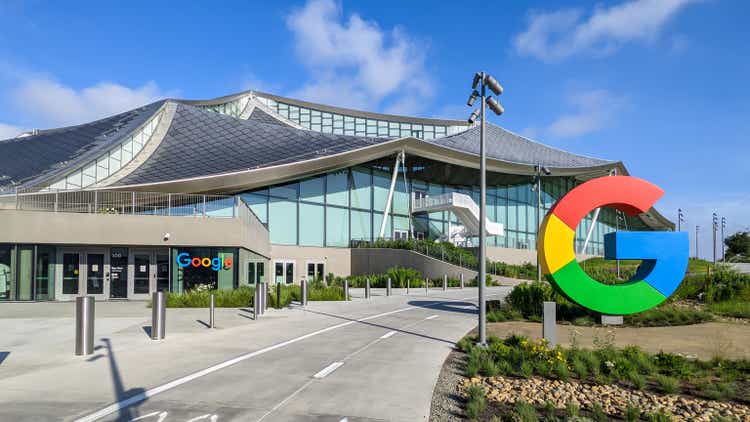JHVEPhoto
Background
Alphabet Inc. (NASDAQ:GOOG, NASDAQ:GOOGL) (“Google”) provided a weak Q3 report. The reduction of advertisers’ advertising budgets and the strengthening of the U.S. dollar had a negative impact on the company’s results. In general, the market reaction (-9%) is quite justified, especially given the deterioration in marginality. In the context of tightening monetary policy, investors are wary of the deterioration of financial indicators. The state of the advertising market is far from perfect, and there is a little chance of its growth in the nearest future.
Nevertheless, Alphabet may come out of the current crisis as an even stronger company than it was before, so I plan to start forming a position in the company’s shares in the nearest future. Let’s dive into the report in order to understand why the current stock price already looks attractive.
Revenue
Revenue growth slowed to a single-digit value, which was strongly influenced by the strengthening of the U.S. dollar. Revenue for the quarter was at $69 billion, which is 6% higher than it was last year, but 2% worse than consensus expected. Excluding the impact of the strengthening dollar, revenue growth was 11% (51% of revenue comes from the regions outside of the United States).
Marginality
EBITDA (GAAP) was $21.1 billion (-13% YoY and 9% worse than expected). The current EBITDA margin is at the level of 31%, a year earlier, it was 37%. The cost of sales increased by 13%, mainly due to an increase in expenses related to data centers and the purchase of servers. Operating expenses increased by 26%. The growth was due to an increase in staff in R&D and G&A, as well as due to an increase in advertising and promotion expenses in S&M. In total, the company’s staff increased by 24% YoY (+12.7 thousand employees). FCF margin was at the level of 23%, which is lower than last year’s level of 29%. A significant slowdown in hiring is expected in Q4 (up to 50% of the Q3 level), so I do not expect further significant deterioration in margins.
Google Search
Google Search revenue was $39.5 billion (+4% YoY, but 4% worse than expected). Google Network segment revenue was at the level of $7.8 billion (-2% YoY and 5% worse than expected). Among advertisers, the largest growth was due to travel companies and retail. The main reduction of advertising budgets was observed in the financial sector (insurance, lending, mortgage and cryptocurrency).
YouTube
The overall decline in the advertising market has also affected YouTube’s performance. The advertising revenue of the service was at the level of $7 billion (-2% YoY and 5% worse than expected). Shorts remained as the main driver of user engagement. However, the company launched the monetization of this service only in September, so, at this point the increase in engagement has not affected the growth of advertising revenue.
I expect that starting from the first quarter of 2023, monetization of Shorts will begin to have a positive impact on the segment results. An additional driver of this will be the launch of the distribution of part of advertising revenue to content creators, as it has already been implemented in other YouTube services. Additionally, I would like to note that YouTube overall user engagement is growing. In September, YouTube’s share in total TV usage updated the maximum value and amounted to 8%.
Google Cloud
The main positive of the report was the results of the Google Cloud segment, which continues to demonstrate a steady high growth rate. Segment revenue was $6.8 billion (+38% YoY and 3% better than consensus expected). Management noted that Google Cloud’s services are already used by more than 8 million businesses around the world. Given the focus on cost optimization in many companies, I think that the high demand for cloud infrastructure will continue. I also note the improvement in the marginality of the segment. The operating margin of the segment was (-10%), which is the best indicator of the segment. In the previous quarter, the margin was at the level of (-14%), and a year earlier, at the level of (-13%).
Risks and Final Thoughts
Despite the negative reporting and the continued reduction of the advertising market, I believe that the current price is already lucrative enough to start forming a position. Of course, there may still be pressure on the company’s shares in the coming days, but as a long-term investment, the shares look attractive. According to my discounted cash flow (“DCF”) model, with the current fundamentals, the fair valuation of the company is at $123 per share. For the most part, all the problems faced by the company are of a short-term nature. I think that among the companies focused on the advertising market, Alphabet has the most stable business model in the context of the continued decline of the advertising market.
However, like any investment, investing in company shares also has a number of risks, so I recommend that you familiarize yourself with all the risks that a company may face in its reporting (10-K).


Be the first to comment